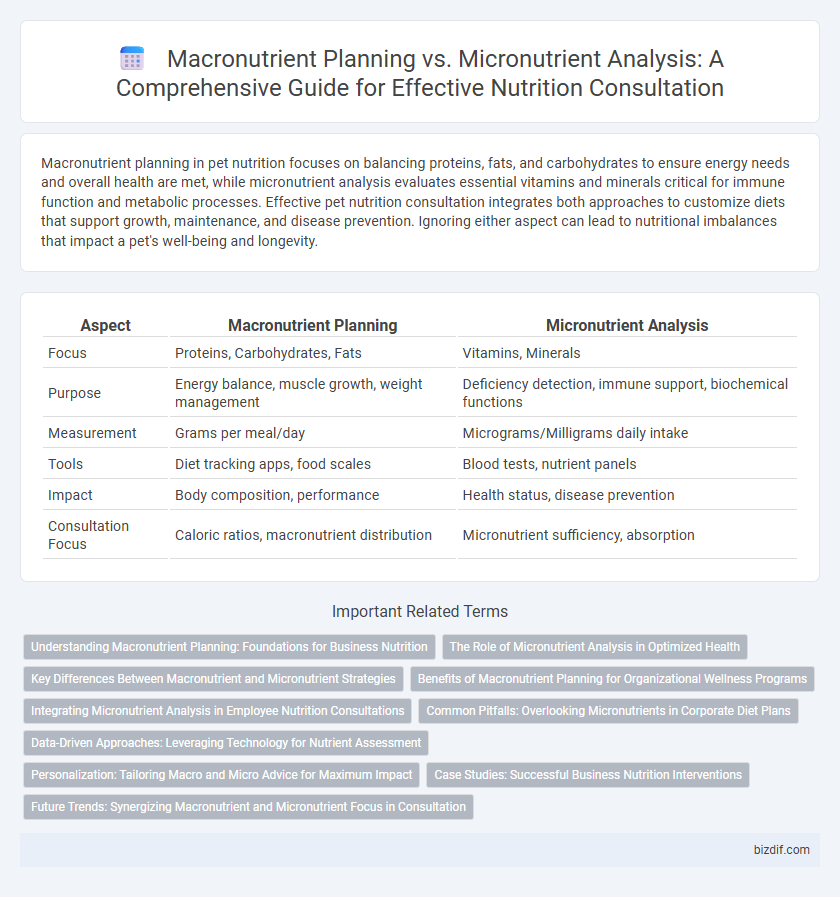Macronutrient planning in pet nutrition focuses on balancing proteins, fats, and carbohydrates to ensure energy needs and overall health are met, while micronutrient analysis evaluates essential vitamins and minerals critical for immune function and metabolic processes. Effective pet nutrition consultation integrates both approaches to customize diets that support growth, maintenance, and disease prevention. Ignoring either aspect can lead to nutritional imbalances that impact a pet's well-being and longevity.
Table of Comparison
| Aspect | Macronutrient Planning | Micronutrient Analysis |
|---|---|---|
| Focus | Proteins, Carbohydrates, Fats | Vitamins, Minerals |
| Purpose | Energy balance, muscle growth, weight management | Deficiency detection, immune support, biochemical functions |
| Measurement | Grams per meal/day | Micrograms/Milligrams daily intake |
| Tools | Diet tracking apps, food scales | Blood tests, nutrient panels |
| Impact | Body composition, performance | Health status, disease prevention |
| Consultation Focus | Caloric ratios, macronutrient distribution | Micronutrient sufficiency, absorption |
Understanding Macronutrient Planning: Foundations for Business Nutrition
Macronutrient planning centers on balancing proteins, carbohydrates, and fats to optimize energy intake and support metabolic health, which is essential for business nutrition strategies targeting employee productivity and wellness. Focusing on macronutrient ratios enables customized meal planning to meet specific performance goals and prevent workplace fatigue. Leveraging data on macronutrient distribution helps organizations design effective nutrition programs that enhance cognitive function, physical stamina, and overall workforce health.
The Role of Micronutrient Analysis in Optimized Health
Micronutrient analysis plays a critical role in optimized health by identifying specific vitamin and mineral deficiencies that macronutrient planning alone cannot address. Understanding individual micronutrient levels enables personalized nutrition strategies that support immune function, energy metabolism, and cellular repair. This targeted approach reduces the risk of chronic diseases and promotes overall wellness beyond general calorie and macronutrient distribution.
Key Differences Between Macronutrient and Micronutrient Strategies
Macronutrient planning emphasizes balancing carbohydrates, proteins, and fats to optimize energy intake and support bodily functions, while micronutrient analysis concentrates on assessing vitamins and minerals critical for metabolic processes and disease prevention. Macronutrient strategies guide overall dietary distribution, targeting calorie needs and macronutrient ratios, whereas micronutrient approaches prioritize identifying deficiencies and ensuring adequate vitamin and mineral consumption. Effective nutrition consultation integrates both methods to create a comprehensive plan that supports energy requirements and micronutrient sufficiency for holistic health.
Benefits of Macronutrient Planning for Organizational Wellness Programs
Macronutrient planning in organizational wellness programs optimizes employee energy levels, promoting sustained productivity and focus throughout the workday. Tailoring carbohydrate, protein, and fat intake supports metabolic health and reduces the risk of chronic diseases, lowering healthcare costs for employers. This strategic approach also enhances cognitive performance and mood stability, fostering a healthier, more engaged workforce.
Integrating Micronutrient Analysis in Employee Nutrition Consultations
Integrating micronutrient analysis into employee nutrition consultations enhances personalized dietary strategies by identifying critical vitamin and mineral deficiencies that macronutrient planning alone may overlook. Tailoring nutrition plans based on micronutrient data supports improved energy metabolism, immune function, and cognitive performance, leading to increased workplace productivity and reduced absenteeism. This comprehensive approach ensures balanced nutrient intake, promoting overall employee health and long-term wellness outcomes.
Common Pitfalls: Overlooking Micronutrients in Corporate Diet Plans
Corporate diet plans often prioritize macronutrient targets like proteins, fats, and carbohydrates while overlooking essential micronutrients such as vitamins and minerals that support metabolic function and immune health. This neglect can lead to micronutrient deficiencies, resulting in decreased energy levels, impaired cognitive function, and increased risk of chronic diseases among employees. Effective nutrition consultation must integrate comprehensive micronutrient analysis to ensure balanced dietary planning that promotes long-term wellness and productivity.
Data-Driven Approaches: Leveraging Technology for Nutrient Assessment
Macronutrient planning utilizes data-driven tools like nutrient tracking apps and AI algorithms to optimize protein, carbohydrate, and fat intake for individualized energy balance and metabolic health. Micronutrient analysis employs advanced laboratory testing and digital nutrient databases to assess vitamins, minerals, and trace elements critical for immune function and cellular processes. Technology integration enhances precision in nutrient assessment, enabling tailored nutrition strategies that improve clinical outcomes and overall wellness.
Personalization: Tailoring Macro and Micro Advice for Maximum Impact
Personalized nutrition consultation emphasizes precise macronutrient planning and detailed micronutrient analysis to optimize individual health outcomes. Tailoring carbohydrate, protein, and fat ratios alongside essential vitamins and minerals addresses unique metabolic needs and lifestyle factors. This dual-focused approach ensures maximum impact by supporting energy balance, immune function, and overall wellness through customized dietary strategies.
Case Studies: Successful Business Nutrition Interventions
Case studies reveal that effective nutrition consultations integrate macronutrient planning with micronutrient analysis to enhance client outcomes. Businesses implementing tailored macronutrient distribution alongside micronutrient optimization report significant improvements in employee health metrics and productivity. These interventions demonstrate the synergy between balanced macronutrient intake and micronutrient sufficiency in achieving sustainable nutritional success.
Future Trends: Synergizing Macronutrient and Micronutrient Focus in Consultation
Future nutrition consultations emphasize integrating macronutrient planning with micronutrient analysis to provide holistic dietary strategies tailored to individual metabolic and genetic profiles. Emerging technologies enable precise monitoring of nutrient absorption and utilization, optimizing energy balance and micronutrient sufficiency simultaneously. This synergistic approach enhances personalized nutrition outcomes and supports preventive health measures by addressing both energy needs and micronutrient adequacy.
Macronutrient Planning vs Micronutrient Analysis Infographic

 bizdif.com
bizdif.com